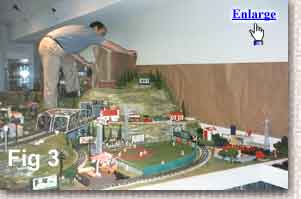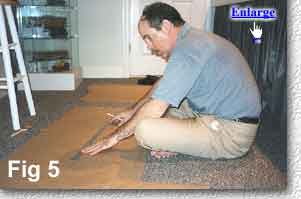INSTALLING A BACKDROP ON AN EXISTING LAYOUT
By Steve Baldwin, Georgia
|
Desired Effect: Blending Mountains with Mountains I have 270 square foot O-gauge train layout on which I can operate up to eight trains on six independent track systems and three different elevations. The layout is packed full of action: 200 linear feet of track, 10 tunnels, over 42 Plasticville structures, 70 original Lionel billboards, and over 300 metal people and animals. The layout was featured on the cover of the July 1997 issue of Classic Toy Trains and has been the subject of a Tracks Ahead segment on PBS television. Yet, something has always been missing from the layout, and a backdrop from Backdrop Warehouse was the perfect solution. Two 15 foot lengths of the layout are open for viewing. The other sides are walled, and one wall has a 42 inch tall mirror along its full 18 foot length. The mirror doubles the apparent size of the layout, and there are bridges that "connect" the image in the mirror to the city pictured in its image. However, the opposite wall has been blank for eight years. Mountains butt against the plain wall. A "mountains with hills" backdrop would allow the structures to blend in and fade into the horizon. That is the desired effect I was seeking.
|
|
Fig. 1 show the plain side and Fig. 2 show the mirrored side, before I began installation. The installation problem was that I was working with an existing layout, had mountain structures that rose higher than the intended base of the backdrop, and often did not have sufficient clearance to "tuck" the backdrop behind these structures. I decided to cut the backdrop to fit around these structures and to increase the apparent height of the backdrop from 36 inches to 42 inches.
|

|
|
Step One: Tracing on Craft Paper I wanted to create a template to use in cutting the backdrop for areas that would lie behind the existing mountain structures. Also, it would have been impossible to "tuck" as much as 24 inches of the backdrop behind these structures. Sometimes, there was no clearance at all because the structures fit snugly against the adjacent wall. Fig. 3 and 4 show me rolling out brown craft paper along the wall to use as a template for cutting the backdrop. I squared the top edge of the paper horizontally with the ceiling and very carefully traced the outline of the mountains and hills that adjoined the plain wall behind them. I didnít want to trace directly onto the backdrop, since the additional handling could have damaged the material or created wrinkles. |

|
|
Step Two: Cutting and Positioning the Template I rolled out the two 10-foot sections of the backdrop onto the floor and left about a 6-inch overlap in the middle where the two sections would join. Later, I planned to trim this down to Ĺ inch overlap. Overall, I was using 20 feet of backdrop to cover an 18 foot wall, so I had some excess to use. After tracing the outline of the mountains onto the brown paper, I removed it from the wall and rolled it out over the backdrop. I shifted the brown paper template left and right to position the mountain scenes so that they would best complement the structures in front of them. I was very happy how well the different parts of the backdrop aligned with the adjacent part of my layout. For example, there is a valley in the middle of my layout, and I aligned a tall mountain in the backdrop so that it would show clearly, rising out of the valley. Fig. 5 and 6 show me cutting along the traced line and checking the position of the template on the backdrop beneath it.
|

|
|
|
Step Three: Cutting the Backdrop for Installation Fig. 7 shows the far left portion of the backdrop and the positioning of the template over the scene that will be removed to fit around the mountaintop airport. Fig. 8 shows this section after the excess portion of the backdrop has been removed. In areas where there was some clearance behind the mountain, I left about a 1 inch overlap for the backdrop to extend or "tuck" behind the mountain structure. I kept whole sections of cut-outs that I had removed from the backdrop. These extra pieces came in very handy at the end of the installation step.
|
................ |
|
Step Four: Installation With an existing layout in place, my installation options were limited to the one that would be the least messy or disruptive. After reading all the carefully-documented installation methods that Backdrop Warehouse showed on its website, I decided to give the two-sided tape method a shot. This method worked extremely well. Standing at each end of the layout, I measured exactly 42 inches above the lowest surface and made a mark on the wall. With my wife at one end and me at the other, we rolled out the two-sided tape, removed one side of the protective covering, and stretched the tape over the two marks on the wall. Aligned with the 42 inch marks, the tape made a perfect horizontal band from which to hang the backdrop. The tape provides an excellent medium for installing the backdrop. However, it can only be adjusted once or twice. After that, the adhesive is so strong that it will pull the paint and drywall surface right up with it.
|
. |
Fig. 9 shows me completing the installation of the left half of the backdrop. You can see how well the cut out portion fit around the top side of the mountain where I have my airport and Plasticville terminal. Once the backdrop was pulled tight. I used a razor blade to cut the excess material along the far left side. I only needed a few 2 to 3 inch sections of tape, every 18 inches or so, to secure the backdrop at the bottom and remove any wrinkles. |
|
Fig. 10 shows the installation of the right side of the backdrop and the matching and overlapping of the two ends. In each case, I worked from the center outward, so that I had a minimum overlap in the middle and all the excess on the left and right ends. Again, a few 2 to 3 inch sections of two-sided tape secured the matched seam in the middle.
|
|
|
. |
Since I wanted the backdrop to be the same height as the mirror on the opposite side, I had created an issue for myself. On one four-foot part of the layout, I had a 6 inch gap between the bottom of the backdrop and the actual layout surface. This is where I decided to innovate. I found that the trees in the cut-out sections that I had removed very closely matched the area of the backdrop from which they had been taken. I used one of these pieces to patch the 6 inch gap that I had created. Before installing the cut-out piece, I carefully cut along the top of a ridge of trees, following the exact profile of the top of each tree with my cut. When installed at the bottom of the wall and overlapping with the main backdrop above it, this patched piece simply gave the image of a smaller hill in the foreground. The color of the trees matched extremely well, as you can see in the photo of the complete installation. |
|
I could not find any instructions on whether to keep the ĺ inch white border or remove it. I decided to leave it to give the backdrop a more finished look. In fact, I removed more of the white strip from the cut-out sections and glued these down to make borders on the right and left vertical sides of the backdrop. I liked the "framing" effect that this provided. |
|
|
|
End Result: What a Difference! Fig. 11 and 13 shows the completed layout with the backdrop installed. Now, my mountain structures blend right into the rolling hills in the backdrop. The clouds and blue sky add a further note of realism. I particularly like to stand in one corner of the room and look across the layout and into the mirror. As shown in Fig. 12, I can see the full layout, the reflection of the city in the mirror and then the backdrop behind it. A massive toy train empire unfolds before my eyes. |
|
|
|
Can you write an Article If you would like to write an article on how you installed your BackDrop, we are interested. Good articles like this one will be included on our web site. Payment is typically around the cost of the backdrops used but may be more or less depending on the number of backdrops involved and the quality of the article. Many well lighted photos are a must. We may submit good articles for review at major model railroad magazines. All photos and text are your property (except we have the right to use any sent to us on this web site) and arrangements for publication and payment are between you and the magazine. We will match the payment from the magazine up to $200 as long as our company is mentioned as the supplier of the backdrops. |